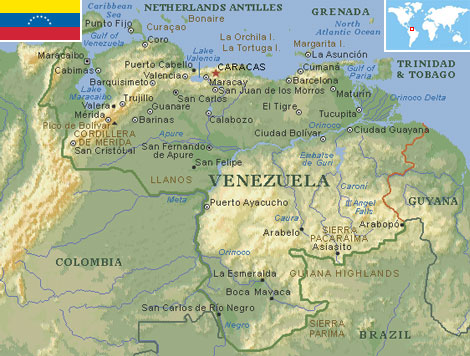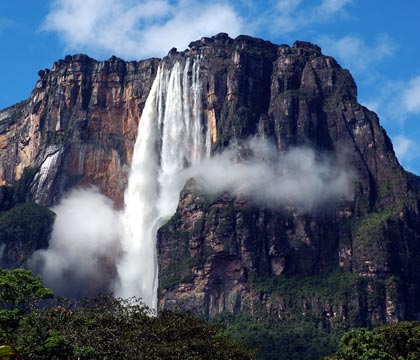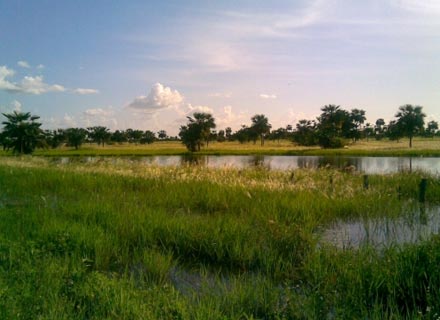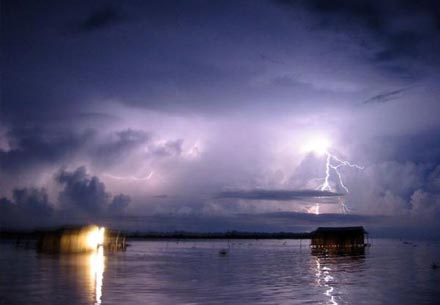Venezuela
Country statistics

Land area: 340,560 sq miles (882,050 sq km)
Total area: 352,144 sq miles (912,050 sq km)
Population (2010 est.): 27,223,228 (growth rate: 1.5%); birth rate: 20.3/1000; infant mortality rate: 21.0/1000; life expectancy: 73.7; density per sq milesle: 77
Capital City: Caracas
Monetary unit: Bolivar
Languages: Spanish (official), numerous indigenous dialects
Ethnicity/race: Spanish, Italian, Portuguese, Arab, German, African, indigenous people
Religions: Roman Catholic 96%, Protestant 2%
Country introduction

Venezuela is a country on the northern coast of South America, bordered on the north by the Caribbean Sea and the Atlantic Ocean, on the east by Guyana, on the south by Brazil, and on the west by Colombia.
Shaped roughly like an inverted triangle, the country has a 2,800 km (1,700 miles) coastline in the north, which includes numerous islands in the Caribbean Sea. The geography of Venezuela can be divided into four well-defined regions: the Maracaibo lowlands in the north-west, the northern mountains extending all the way to the Caribbean Sea, the wide Orinoco plains (Los Llanos) in Central Venezuela and the Guiana Highlands in the south-east.
The Maracaibo lowlands is basically flat with some gentle slopes from sections near the enclosed mountains and highlands. In this area lies Venezuela's largest and most important industrial city, Maracaibo. This region is also notable for having the largest lake in South America, Maracaibo Lake.
Parts of the north-eastern sections of the Andes Mountains are to the north of the country. This is where the highest peak in Venezuela, the Pico Bolivar is located, which rises to a height of 5,007 m (16,427 ft).
The plains of Orinoco is a region of tropical grasslands that extend westward from the Caribbean coast to the Colombian border between the northern mountains and the Río Orinoco. This region is commonly known as the Llanos and covers about one third of the country. It gets flooded in the rainy season and burnt dry during the other half of the year when no rain falls. Hundreds of animal species live in perfect harmony with this difficult environment, including many endangered species such as the Orinoco crocodile, Orinoco turtle, giant armadillo, giant otter, black-and-chestnut eagle, dickcissel and several species of catfish. It is also home to the largest rodent in the world, the capybara, and the largest existing boa in the world, the anaconda, which is over 7 m (23 ft) long. The wetlands found in this region are among the most important areas for neotropical migratory birds and in particular, shorebirds like yellowlegs and several species of sandpipers.
The Guiana highlands is a heavily forested plateau that is located north of the Amazon Basin and south of the Orinoco River. The river is more than 2,500 km (1,553 miles) long making it the largest in South America and the eighth largest in the world. It is also notable for creating the world's highest waterfall, Angel Falls.
The culture

Venezuela culture has been greatly influenced by its history. The native, pre-Hispanic communities and the Spanish conquest around 1500 all had a considerable influence in the culture of the land.
Venezuela has a strong folk culture. Many regions have well-known symbolic icons which personify their cultural roots. Most significant are the andinos (the hardy mountain folk), the guayanés (the tough frontiersman following a dream), the llanero (the cowboy of the Llanos), and the maracucho (the energetic entrepreneur of the Maracaibo area).
The national musical instrument is the cuatro, while the national dance is joropo. Typical musical styles are Alma Llanera and gaita. Although soccer is a popular sport for most of the South American nations, baseball is the national sport of this country, showing the extent of American influence on Venezuelan culture.
Art of pre-Columbian cultures mainly consisted of rock carvings and cave paintings in the form of petroglyphs. The colonial era was characterized by religious painting and sculpture in Spanish style, of which notable examples include the sculpture St. Peter the Apostle by Enrique Antonio Hernández Prieto, and Antonio José Landaeta's painting The Immaculate Conception. In the years following independence, history took over from religion as the dominant theme of art, a genre best illustrated by the exceptional work of Martín Tovar y Tovar. 20th century art has been marked by modernism, and many changes of style occurred in the 1930s and 1940s. Kinetic art has emerged in the last few decades, and has been most successfully represented by the work of Carlos Cruz Díez and Jesús Soto.
Festivals in Venezuela bring color and fun to the country and lets the Venezuelans enjoy their culture and heritage. Important Venezuelan festivals include the Procession of the Holy Shepherdess, La Paradura del Nino, Drumming Feast of St. John and the May Cross Celebrations. The most popular festival is the Carnival in Venezuela, which is celebrated in the month of February, forty days before Easter Sunday every year in coastal towns and villages. El Callao is another popular carnival in Venezuela that attracts a great number of tourists from far and wide for the four-day event. It was founded in 1853 during the big gold mining rush, which attracted gold-hunting adventurers from England in the United Kingdom, America, France and the Caribbean Islands. To find release from the endless hours of labour in the gold mines, people would unwind at carnival time.
Attractions & landmarks

Venezuela's top tourist attractions is the world's highest waterfall, the Angel Falls, at a height of 979 m (3,212 ft). The falls are located in Canaima National Park, the second largest in the country, after Parima-Tapirapecó, and sixth biggest national park in the world. About 65% of the park is occupied by plateaus of rock called tepuis, which are a kind of plateau of millions of years old, with vertical walls and almost flat tops. The most famous tepuis in the park are Mount Roraima, the tallest and easiest to climb, and Auyantepui, the site of Angel Falls.
Although the Caribbean Islands of Aruba and Curacao draw a large number of guests to their sandy beaches, the equally comparable sea setting of Los Roques is becoming a top destination of Venezuela. The name of Los Roques actually refers to the group of islands that lie off the coast of Venezuela and the total area is about 225,000 hectares of both land and sea. The presence of coral reefs in this area make it an excellent destination for diving or norkeling and the beaches have also become a hotspot for windsurfing.
The Los Llanos region is also seeing a growth in tourism. The landscape is mostly plains, covering much of Central and South-western Venezuela with a wide diversity of fauna and flora. Safaris are available in one of the ranches in the region, allowing visitors to try and spot the legendary anaconda snake, jaguars, anteaters, and caimans. This is also the last stronghold of the Orinoco Crocodile.
The city of Maracaibo is home to the biggest lake in South America, Lake Maracaibo. It covers an area of about 5,150 sq miles (13,300 sq km) and is famed for the Catatumbo Lightning, an extraordinary atmospheric phenomenon where lightning storms take place 140-160 days per year, that lasts for up to 10 hours and features bolts 4 km (3 miles) long.
The Andes Mountain is another popular attraction in Western Venezuela. The beautiful mountain is spread across the states of Mérida, Trujillo and Táchira and is home to some exceptional trek routes. The Sierra Nevada de Mérida, part of the northern extent of the Andes Mountains is the highest mountain range, which includes the highest peaks in Venezuela, Pico Bolívar with an elevation of 4,981 m (16,342 ft).
Venezuela is also famous for having the world's highest cable car, which is located in Mérida, at the foot of the Andes. It takes visitors 12.5 km (7 miles) from the bottom station of Barinitas (1577 m / 5174 ft) to the top of Pico Espejo (4765 m / 15,633 ft) in four stages.